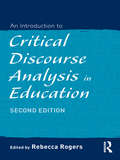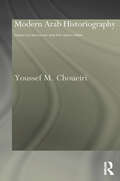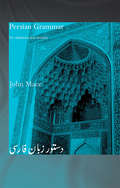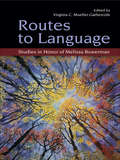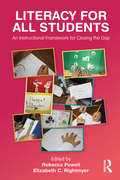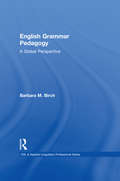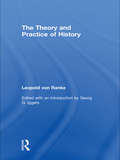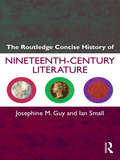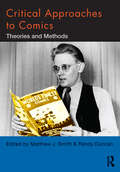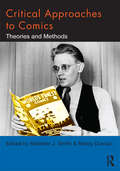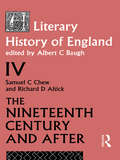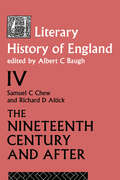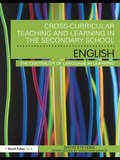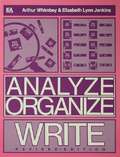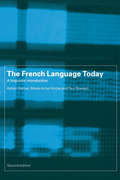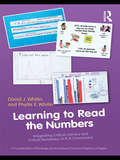- Table View
- List View
An Introduction to Critical Discourse Analysis in Education
by Rebecca RogersAccessible yet theoretically rich, this landmark text introduces key concepts and issues in critical discourse analysis and situates these within the field of educational research. The book invites readers to consider the theories and methods of three major traditions in critical discourse studies – discourse analysis, critical discourse analysis, and multimodal discourse analysis -- through the empirical work of leading scholars in the field. Beyond providing a useful overview, it contextualizes CDA in a wide range of learning environments and identifies how CDA can shed new insights on learning and social change. Detailed analytic procedures are included – to demystify the process of conducting CDA, to invite conversations about issues of trustworthiness of interpretations and their value to educational contexts, and to encourage researchers to build on the scholarship in critical discourse studies. This edition features a new structure; a touchstone chapter in each section by a recognized expert (Gee, Fairclough, Kress); and a stronger international focus on both theories and methods. NEW! Companion Website with Chapter Extensions; Interviews; Bibliographies; and Resources for Teaching Critical Discourse Analysis.
Modern Arab Historiography: Historical Discourse and the Nation-State
by Youssef ChoueiriInclusing a new introduction and conclusion, this revised second edition deals with a vital yet neglected ingredient in modern Arab culture. It is the only scholarly study of Arab historiography. It covers the periods 1820-1920 (Pioneers and Amateurs) and 1920 to today (Professional Historians: Managers of Legitimation). This work is a major contribution not only to the study of Arab historiography but to our understanding of modern Arab thought.
Modern Arab Historiography: Historical Discourse and the Nation-State
by Youssef ChoueiriInclusing a new introduction and conclusion, this revised second edition deals with a vital yet neglected ingredient in modern Arab culture. It is the only scholarly study of Arab historiography. It covers the periods 1820-1920 (Pioneers and Amateurs) and 1920 to today (Professional Historians: Managers of Legitimation). This work is a major contribution not only to the study of Arab historiography but to our understanding of modern Arab thought.
Persian Grammar: For Reference and Revision
by John MaceThis is a book for reference and revision, especially for those in the early stages of studying the Persian language. It uses the official reformed spelling, and gives attention to handwriting, educated standard and educated colloquial pronunciation, and the important polite forms. The grammar is explained with copious examples, all shown both in Persian script and in Roman transliteration. The grammatical themes are grouped logically, and there are cross-references, appendices and a subject index to facilitate the search for the right form.
Routes to Language: Studies in Honor of Melissa Bowerman
by Virginia C. Mueller GathercoleThis volume contains contributions from leaders in the field of child language in honor of one of the preeminent scholars in the field of child language acquisition, Melissa Bowerman. Melissa Bowerman has had a profound, widespread, and enduring influence on research conducted in the field for nearly 40 years. In addition to being a tribute to Professor Bowerman and her work, the chapters provide the most up-to-date statement of key positions by several leaders in the field of child language development. Fundamental questions in the field are explored in depth, and there are rich analyses of progress in the field in a number of areas, including learning words; crosslinguistic patterning and acquisition of lexical semantics; crosslinguistic patterning and events, paths, and causes; and influences on development. The volume is essential reading for researchers in child language and development, linguistics, psychology, education, and speech pathology, as well as researchers and practitioners specializing in the many specific languages discussed in the book.
Routes to Language: Studies in Honor of Melissa Bowerman
by Virginia C. Mueller GathercoleThis volume contains contributions from leaders in the field of child language in honor of one of the preeminent scholars in the field of child language acquisition, Melissa Bowerman. Melissa Bowerman has had a profound, widespread, and enduring influence on research conducted in the field for nearly 40 years. In addition to being a tribute to Professor Bowerman and her work, the chapters provide the most up-to-date statement of key positions by several leaders in the field of child language development. Fundamental questions in the field are explored in depth, and there are rich analyses of progress in the field in a number of areas, including learning words; crosslinguistic patterning and acquisition of lexical semantics; crosslinguistic patterning and events, paths, and causes; and influences on development. The volume is essential reading for researchers in child language and development, linguistics, psychology, education, and speech pathology, as well as researchers and practitioners specializing in the many specific languages discussed in the book.
Literacy for All Students: An Instructional Framework for Closing the Gap
by Rebecca Powell Elizabeth RightmyerThe Culturally Responsive Instruction Observation Protocol (CRIOP) is a framework for implementing culturally relevant literacy instruction and classroom observation. Drawing on research and theory reflecting a range of perspectives ? multicultural instruction, literacy theory, equity pedagogy, language and discourse models, sheltered instruction, critical pedagogy ? it provides a means for assessing the many variables of classroom literacy instruction and for guiding practitioners in their development as multicultural educators. Literacy for All Students Discusses issues in multicultural literacy instruction within the context of various essential instructional components (such as assessment, curriculum, parent collaboration) Provides a protocol for observing features of literacy instruction for culturally and linguistically diverse students Presents vignettes from real classrooms, written by elementary and middle school teachers, showing their victories and struggles as they attempt to implement a pedagogy that is culturally responsive within a climate of high stakes testing A highly effective instrument for assessing culturally responsive literacy instruction in schools, the CRIOP serves as a model for realizing a literacy that is both relevant and transformative.
Literacy for All Students: An Instructional Framework for Closing the Gap
by Rebecca Powell Elizabeth RightmyerThe Culturally Responsive Instruction Observation Protocol (CRIOP) is a framework for implementing culturally relevant literacy instruction and classroom observation. Drawing on research and theory reflecting a range of perspectives ? multicultural instruction, literacy theory, equity pedagogy, language and discourse models, sheltered instruction, critical pedagogy ? it provides a means for assessing the many variables of classroom literacy instruction and for guiding practitioners in their development as multicultural educators. Literacy for All Students Discusses issues in multicultural literacy instruction within the context of various essential instructional components (such as assessment, curriculum, parent collaboration) Provides a protocol for observing features of literacy instruction for culturally and linguistically diverse students Presents vignettes from real classrooms, written by elementary and middle school teachers, showing their victories and struggles as they attempt to implement a pedagogy that is culturally responsive within a climate of high stakes testing A highly effective instrument for assessing culturally responsive literacy instruction in schools, the CRIOP serves as a model for realizing a literacy that is both relevant and transformative.
English Grammar Pedagogy: A Global Perspective
by Barbara M. BirchDesigned for ESL and ELT pedagogy courses around the world, this text describes English grammar from a World Englishes perspective. It is distinguished by its focus on the social setting for English as a global language, the latest thinking about grammatical theory, and new theories of how first and second languages are learned and taught. The fundamental premise is that teaching and learning grammar cannot be isolated from the local, regional, and global sociocultural contexts in which the teaching and learning take place. Part I presents different attitudes toward English as a global language and some challenges that learners of English share no matter where they are in the world. Part II is about the features of English that educated speakers consider the most likely and probable in Academic English. Part III describes the flexible and fluid features of English that might be susceptible to change or modification over time. Each chapter includes engaging Study, Discussion, and Essay Questions and Activities.
English Grammar Pedagogy: A Global Perspective
by Barbara M. BirchDesigned for ESL and ELT pedagogy courses around the world, this text describes English grammar from a World Englishes perspective. It is distinguished by its focus on the social setting for English as a global language, the latest thinking about grammatical theory, and new theories of how first and second languages are learned and taught. The fundamental premise is that teaching and learning grammar cannot be isolated from the local, regional, and global sociocultural contexts in which the teaching and learning take place. Part I presents different attitudes toward English as a global language and some challenges that learners of English share no matter where they are in the world. Part II is about the features of English that educated speakers consider the most likely and probable in Academic English. Part III describes the flexible and fluid features of English that might be susceptible to change or modification over time. Each chapter includes engaging Study, Discussion, and Essay Questions and Activities.
The Theory and Practice of History: Edited with an introduction by Georg G. Iggers
by Leopold Von Ranke Georg G. IggersLeopold von Ranke, who was born in 1795, is considered to be one of the founders of the modern practice of writing history. This collection of his writings, edited and introduced by Georg G. Iggers, was first published in 1973 and remains the leading collection of Ranke’s writings in the English language. Now updated with the needs of current students in mind, this edition includes previously untranslated materials by the young Ranke, focusing particularly on the relationship between history and religion together with his inaugural lecture of 1836 ‘On the Relation and Difference between History and Politics’. Including pieces on historical science, and on the relationship between history and philosophy, as well as country specific histories, this book is essential reading for all students of historiography.
The Theory and Practice of History: Edited with an introduction by Georg G. Iggers
by Leopold Von Ranke Georg G. IggersLeopold von Ranke, who was born in 1795, is considered to be one of the founders of the modern practice of writing history. This collection of his writings, edited and introduced by Georg G. Iggers, was first published in 1973 and remains the leading collection of Ranke’s writings in the English language. Now updated with the needs of current students in mind, this edition includes previously untranslated materials by the young Ranke, focusing particularly on the relationship between history and religion together with his inaugural lecture of 1836 ‘On the Relation and Difference between History and Politics’. Including pieces on historical science, and on the relationship between history and philosophy, as well as country specific histories, this book is essential reading for all students of historiography.
The Routledge Concise History of Nineteenth-Century Literature
by Josephine Guy Ian SmallNineteenth-century Britain saw the rise of secularism, the development of a modern capitalist economy, multi-party democracy, and an explosive growth in technological, scientific and medical knowledge. It also witnessed the emergence of a mass literary culture which changed permanently the relationships between writers, readers and publishers.Focusing on the work of British and Irish authors, The Routledge Concise History of Nineteenth-Century Literature: considers changes in literary forms, styles and genres, as well as in critical discourses examines literary movements such as Romanticism, Pre-Raphaelitism, Aestheticism and Decadence considers the work of a wide range of canonical and non-canonical writers discusses the impact of gender studies, queer theory, postcolonialism and book history contains useful, student-friendly features such as explanatory text boxes, chapter summaries, a detailed glossary and suggestions for further reading. In their lucid and accessible manner, Josephine M. Guy and Ian Small provide readers with an understanding of the complexity and variety of nineteenth-century literary culture, as well as the historical conditions which produced it.
The Routledge Concise History of Nineteenth-Century Literature
by Josephine Guy Ian SmallNineteenth-century Britain saw the rise of secularism, the development of a modern capitalist economy, multi-party democracy, and an explosive growth in technological, scientific and medical knowledge. It also witnessed the emergence of a mass literary culture which changed permanently the relationships between writers, readers and publishers.Focusing on the work of British and Irish authors, The Routledge Concise History of Nineteenth-Century Literature: considers changes in literary forms, styles and genres, as well as in critical discourses examines literary movements such as Romanticism, Pre-Raphaelitism, Aestheticism and Decadence considers the work of a wide range of canonical and non-canonical writers discusses the impact of gender studies, queer theory, postcolonialism and book history contains useful, student-friendly features such as explanatory text boxes, chapter summaries, a detailed glossary and suggestions for further reading. In their lucid and accessible manner, Josephine M. Guy and Ian Small provide readers with an understanding of the complexity and variety of nineteenth-century literary culture, as well as the historical conditions which produced it.
Critical Approaches to Comics: Theories and Methods
by Matthew J. Smith Randy DuncanCritical Approaches to Comics offers students a deeper understanding of the artistic and cultural significance of comic books and graphic novels by introducing key theories and critical methods for analyzing comics. Each chapter explains and then demonstrates a critical method or approach, which students can then apply to interrogate and critique the meanings and forms of comic books, graphic novels, and other sequential art. The authors introduce a wide range of critical perspectives on comics, including fandom, genre, intertextuality, adaptation, gender, narrative, formalism, visual culture, and much more. As the first comprehensive introduction to critical methods for studying comics, Critical Approaches to Comics is the ideal textbook for a variety of courses in comics studies. Contributors: Henry Jenkins, David Berona, Joseph Witek, Randy Duncan, Marc Singer, Pascal Lefevre, Andrei Molotiu, Jeff McLaughlin, Amy Kiste Nyberg, Christopher Murray, Mark Rogers, Ian Gordon, Stanford Carpenter, Matthew J. Smith, Brad J. Ricca, Peter Coogan, Leonard Rifas, Jennifer K. Stuller, Ana Merino, Mel Gibson, Jeffrey A. Brown, Brian Swafford
Critical Approaches to Comics: Theories and Methods
by Matthew J. Smith Randy DuncanCritical Approaches to Comics offers students a deeper understanding of the artistic and cultural significance of comic books and graphic novels by introducing key theories and critical methods for analyzing comics. Each chapter explains and then demonstrates a critical method or approach, which students can then apply to interrogate and critique the meanings and forms of comic books, graphic novels, and other sequential art. The authors introduce a wide range of critical perspectives on comics, including fandom, genre, intertextuality, adaptation, gender, narrative, formalism, visual culture, and much more. As the first comprehensive introduction to critical methods for studying comics, Critical Approaches to Comics is the ideal textbook for a variety of courses in comics studies. Contributors: Henry Jenkins, David Berona, Joseph Witek, Randy Duncan, Marc Singer, Pascal Lefevre, Andrei Molotiu, Jeff McLaughlin, Amy Kiste Nyberg, Christopher Murray, Mark Rogers, Ian Gordon, Stanford Carpenter, Matthew J. Smith, Brad J. Ricca, Peter Coogan, Leonard Rifas, Jennifer K. Stuller, Ana Merino, Mel Gibson, Jeffrey A. Brown, Brian Swafford
A Literary History of England Vol. 4
by A BaughFirst published in 1959. Routledge is an imprint of Taylor & Francis, an informa company.
A Literary History of England Vol. 4
by A BaughFirst published in 1959. Routledge is an imprint of Taylor & Francis, an informa company.
Cross-Curricular Teaching and Learning in the Secondary School ... English: The Centrality of Language in Learning
by David StevensWhat is the role of the individual school 'subject' and 'subject teacher' within school? Is it to teach a set of core subject knowledge, skills and understanding in a way that remains faithful to long-standing subject cultures and pedagogies? Or is there another way to consider how the curriculum and the notion of individual subjects and teachers' pedagogy could be constructed? Cross-Curricular Teaching and Learning in the Secondary School ... English brings together ongoing debates about personalised learning, creativity and ICT in education to establish a clear theoretical framework for cross-curricular teaching and learning in English and literacy. Presenting an appropriate pedagogy for cross-curricular teaching that draws on this framework, it promotes radical new approaches to English teaching as part of a widened curriculum through practical examples and theoretical discussions, blended with engaging stories of current practice. With links to other curriculum subjects and current education policy, features include: theoretical examination of key issues; assessment of the strengths and weaknesses of different curricular models; clear principles for effective assessment; a wide range of case studies; summaries of key research linked to suggestions for further reading; professional development activities to promote cross-curricular dialogue. Part of the Cross-Curricular Teaching and Learning in the Secondary School series, this timely, interdisciplinary textbook is essential reading for all students on Initial Teacher Training courses and practising teachers looking to holistically introduce cross-curricular themes and practices in secondary English teaching.
Cross-Curricular Teaching and Learning in the Secondary School ... English: The Centrality of Language in Learning
by David StevensWhat is the role of the individual school 'subject' and 'subject teacher' within school? Is it to teach a set of core subject knowledge, skills and understanding in a way that remains faithful to long-standing subject cultures and pedagogies? Or is there another way to consider how the curriculum and the notion of individual subjects and teachers' pedagogy could be constructed? Cross-Curricular Teaching and Learning in the Secondary School ... English brings together ongoing debates about personalised learning, creativity and ICT in education to establish a clear theoretical framework for cross-curricular teaching and learning in English and literacy. Presenting an appropriate pedagogy for cross-curricular teaching that draws on this framework, it promotes radical new approaches to English teaching as part of a widened curriculum through practical examples and theoretical discussions, blended with engaging stories of current practice. With links to other curriculum subjects and current education policy, features include: theoretical examination of key issues; assessment of the strengths and weaknesses of different curricular models; clear principles for effective assessment; a wide range of case studies; summaries of key research linked to suggestions for further reading; professional development activities to promote cross-curricular dialogue. Part of the Cross-Curricular Teaching and Learning in the Secondary School series, this timely, interdisciplinary textbook is essential reading for all students on Initial Teacher Training courses and practising teachers looking to holistically introduce cross-curricular themes and practices in secondary English teaching.
Analyze, Organize, Write
by Arthur Whimbey Elizabeth Lynn JenkinsThis book offers students a method for understanding and mastering the rhetorical patterns that comprise expository writing. Its exercises ask students to arrange jumbled sentences into logical order, forming model essays for standard rhetorical patterns such as comparison/contrast, classification, and thesis support. These techniques force students to see the basic logic of different writing patterns. The goal of Whimbey's workbook is to teach the student to write concise and original essays on any topic.
Analyze, Organize, Write
by Arthur Whimbey Elizabeth Lynn JenkinsThis book offers students a method for understanding and mastering the rhetorical patterns that comprise expository writing. Its exercises ask students to arrange jumbled sentences into logical order, forming model essays for standard rhetorical patterns such as comparison/contrast, classification, and thesis support. These techniques force students to see the basic logic of different writing patterns. The goal of Whimbey's workbook is to teach the student to write concise and original essays on any topic.
The French Language Today: A Linguistic Introduction
by Adrian Battye Marie-Anne Hintze Paul RowlettThis book provides a comprehensive introduction to the French language from the perspective of modern linguistics. Placing French within its social and historical context, the authors highlight the complex, diverse aspects of the language in a lively and accessible way. A variety of topics is covered, including the distribution of French in the world, the historical development of standard French, the sound system of French, its sentence patterns, and its stylistic and geographical variations.Fully updated and revised, this new edition places a greater emphasis on sociolinguistics. To make the book more user-friendly, the following new features have been added:* a further reading guide at the end of each chapter* a glossary of linguistic terms* an expanded bibliography and index.
The French Language Today: A Linguistic Introduction
by Adrian Battye Marie-Anne Hintze Paul RowlettThis book provides a comprehensive introduction to the French language from the perspective of modern linguistics. Placing French within its social and historical context, the authors highlight the complex, diverse aspects of the language in a lively and accessible way. A variety of topics is covered, including the distribution of French in the world, the historical development of standard French, the sound system of French, its sentence patterns, and its stylistic and geographical variations.Fully updated and revised, this new edition places a greater emphasis on sociolinguistics. To make the book more user-friendly, the following new features have been added:* a further reading guide at the end of each chapter* a glossary of linguistic terms* an expanded bibliography and index.
Learning to Read the Numbers: Integrating Critical Literacy and Critical Numeracy in K-8 Classrooms. A Co-Publication of The National Council of Teachers of English and Routledge
by David J. Whitin Phyllis E. WhitinBeing a critical reader of numerical information is an integral part of being literate in today’s data-drenched world. Uniquely addressing both mathematics and language issues, this text shows how critical readers dig beneath the surface of data to better evaluate their usefulness and to understand how numbers are constructed by authors to portray a certain version of reality. Engaging, concise, and rich with examples and clear connections to classroom practice, it provides a framework of critical questions that children and teachers can pose to crack open authors’ intentions, expose their decisions, and make clear who are the winners and losers – questions that are essential for building democratic classrooms. Explaining and illustrating how K-8 teachers can engage students in developing the ability to be both critical composers and critical readers of texts, Learning to Read the Numbers is designed for teacher education courses across the areas of language arts, mathematics, and curriculum studies, and for elementary teachers, administrators, and literacy and mathematics coaches. Learning to Read the Numbers is a co-publication of The National Council of Teachers of English (www.ncte.org) and Routledge.
